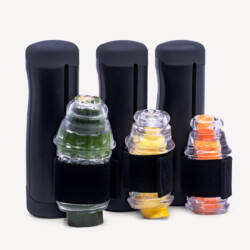The Future of Male Birth Control Is Near
New research could lead to fast-acting contraceptives for men.

One of the most significant developments of the 20th century was the approval of the first oral contraceptive for women—forever known as the Pill. As one of the catalysts of the sexual revolution of the 1960s, oral contraception ushered in both social and medical advances—as well as some negative side effects. Sure, women were able to enjoy their sexualities without fear of pregnancy, but to reap that pleasure benefit some have endured health consequences.
The most common side effects women experience in using the Pill are nausea, breast tenderness, headaches, weight gain, mood changes, missed periods, decreased libido, and more. Would the potential for negative side effects be lessened if birth control were administered to men? Pregnancy is, after all, something that usually takes two people to make happen. When will men be the ones to carry the burden of reproductive intervention?
History of male birth control
Medical male contraceptive has been the white whale of the sexual world ever since the Pill itself was released for general use. There have been numerous attempts to find an effective male birth control, but none have proven successful in the long run. A recent controversy revealed significant issues with tests and trial for a male contraceptive, however, similar side effects were largely ignored in the development of female contraceptives. Instead, barrier methods, such as condoms, remain the most widely accepted form of male birth control.
There are, fortunately, some significant advances taking place with the hope of establishing a better balance among the sexes. Recently reported research from a UK-based team shows that a unique approach just might be a much-needed new direction—backwards.
Reverse approach to research
As in all fields, innovation can be the catalyst to growth and understanding. Professor John Howl and his research team followed a reverse engineering approach to their contraception research. Based on data indicating that most instances of male infertility are the result of low sperm motility, Howl attempted to eliminate sperm motility. If the swimmers can’t swim, they won’t do their thing.

In their research, Howl’s team discovered that cell penetrating peptides (CPPS), proteins that can occur naturally or be synthesized, can manipulate the actions of sperm. One of those controls is causing the sperm to be inactive. The CPPs are amino acid chains that can penetrate a sperm and can be targeted to act on the protein that guides the sperm to swim. So far, the CPPs have been tested on human and cow sperm with promising results.
Effective administration
One of the most intriguing aspects of this advance—and what gives it such strong potential—is that it might be possible to use it on a case-by-case basis. Howl notes that this method may possibly be administered in a fast-acting pill form or maybe even a nasal spray. The important factor here is its fast-acting nature. Howl notes that the CPPs disable the sperm very quickly.
Another key factor is the short-range efficacy of the CPPs. For women to return to being fertile, they must stop taking the Pill for weeks, possibly months. Hormonal contraceptive takes a significant amount of time to wear off. Conversely, the effects of CPPs are gone within days.
Challenges of male birth control
Is there a future for this type of male birth control? Unfortunately, the answer to that lies less in the science and more in the social. The science is quite promising. If the sperm can be safely stopped without the need to take a daily pill and there are no significant side effects, men will be interested in CPP birth control. Because it might be so fast-acting, it could be dubbed an invisible condom. And if fellas can get away from condoms as birth control, they surely will.
That said, there are still many men who do not buy into the idea of using condoms and believe birth control is the responsibility of the woman. Because the Pill made such an impact, and was so widely discussed, recognized, and fought for by women, the misconception that they are solely responsible is deeply ingrained.
Entirely sexist, but it is deeply entrenched in our social sexual fabric. Despite the numerous side effects women deal with. Despite the ideals of mutual consent. And because of these poor attitudes, women would be fully justified in doubting whether or not men have actually taken their contraceptive, unless it can be seen. Condoms at least afford that recognition.
This is what makes Howl’s research and its nasal spray application so intriguing for future birth control. Just like a condom, it is a visual acknowledgment of compliance and use. Just like a condom, it could even be incorporated into the sexual activity. And if it works as well as early tests indicate, couples will have a solid basis of trust. That just might be the most important advance made when male contraceptive becomes available.
Image sources: Marcus Quigmire, Zappys Technology Solutions
Leave a reply
You must be logged in to post a comment.

















